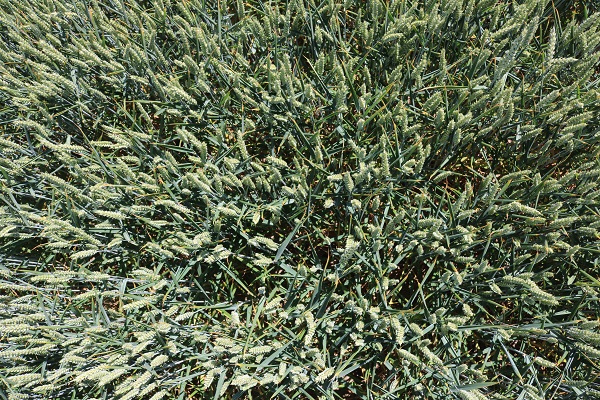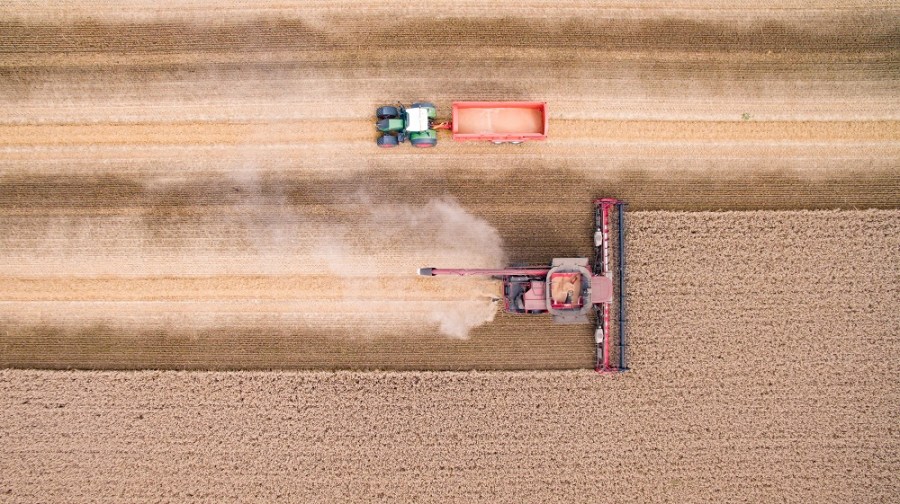The YEN results for 2018 reveal some jaw-dropping yields. But every grower could build crop momentum and achieve maximum crop potential, says ADAS. CPM finds out how.
Crop momentum is another way of saying attention to detail, but it’s more than that.
By Tom Allen-Stevens
Have you ever had a wheat crop for which you think you’ve done everything, and then been disappointed when the combine’s gone through? Perhaps your oilseed rape, despite looking amazing all season, senesces suspiciously early.
Crop physiologists at ADAS have now coined a phrase for that nirvana when everything comes together and the crop rewards you with the satisfaction of living for longer and producing a truly marvellous yield – crop momentum.
“It’s an outcome of the Yield Enhancement Network (YEN). Crop momentum is another way of saying attention to detail, but it’s more than that,” explains Prof Roger Sylvester-Bradley, ADAS head of crop performance.

A wheat crop will put on an extra 0.18t/ha per day that green leaf area is prolonged
“Lincs grower Tim Lamyman, who frequently achieves the top crops in YEN is the arch momentum exponent. Tim doesn’t want his crop to have any setbacks, but he doesn’t just throw everything at it. He tries to understand its needs and supplies those in the correct form, at the right dose and timing.”
Ever since YEN started in 2012, it’s been one of its guiding principles that the longer you can keep a crop going the better. Research has shown that a wheat crop will put on an extra 0.18t/ha per day that green leaf area index is above 2. This allows the plant to continue to capture the energy from that brilliant June and July sunshine and turn it into yield, providing it can get hold of the water and nutrients it needs.
And therein lies the rub – crop physiologists have a very strong conviction in light capture and how that relates to yield. What’s confounded them for decades is exactly how you influence this activity.
“Scientists explain this in terms of source and sink,” says Roger. “A plant makes assimilate – the source – and has to find somewhere to put it – the sink. To optimise yield you have to ensure the plant has both. Barley for example tends to be sink-limited and sets its capacity early in the season because it produces just one grain per spikelet. That’s why it’s important to feed the crop early so it tillers well and lays down plenty of spikelets. If you don’t, it doesn’t matter how much nutrient, water and sunlight the crop gets when it’s filling the ear, it won’t produce any more grains.”
Wheat is more flexible, especially in terms of the number of spikelets it sets. “So in YEN, we’re extending that thinking to what we can do for the crop throughout the growing season, from beginning to end,” he continues.
“It may come down to the size of each leaf, for example – any leaf’s growth will in part be determined by the size of its predecessor, how well it’s photosynthesising and supplying the assimilate to make it grow. You can imagine it as a snowball effect that will come true if you give the plant everything it needs at every stage.”
Identifying and quantifying these needs are the main challenges in sustaining momentum though – many trials that have looked at single treatments in isolation have by and large failed to produce a conclusive result. Roger is interested in whether this is largely why inputs such as micronutrients, amino acids and biostimulants, for example, often get a bad reputation for not achieving the level of response suggested by their manufacturers.
“So the aim with crop momentum is to build an entire approach. There may be more value in developing a crop management system than in proving individual products, because factors such as site, soil type and variety may easily influence which factors are limiting – whereas the best strategy may be simply to keep avoiding limitations.”
So how can you give your crop momentum? The first step is to monitor and measure, says Roger, and that lies at the heart of YEN. “Everyone who joins gets suggestions on what they should be monitoring, and when, from soil samples, to ground cover to ear numbers, to the final grain sample at harvest.”
The samples and records sent in build the data put into every YEN entrant’s report and bring you around 80 different criteria about your crop. For each metric, your value is shown alongside the results from all the other YEN farmers. This, along with the AHDB benchmark and critical value, allow you to assess where exactly your crop may be underperforming and whether you can do anything about it.
Putting some rigour into this aspect is the aim of the YEN Yield-Testing project, that started last year.
“Some growers wanted to test the idea of generating momentum so we’ve introduced crop momentum as one of the topics within the on-farm trials. ‘No setbacks’ is the philosophy that farmers in this group will be following, and they’ll get support throughout the year to help them achieve this,” says Roger.
YEN growers are already achieving yields well above the national average, but Roger believes there’s scope to take it further. “We’re now mining YEN’s expanding treasure-trove of data, so that all YEN participants – both farmers and sponsors – can gauge where they might best target their efforts. There’s no reason why any farmer in the UK can’t match, or even beat, the high achievers in the YEN.”
Winners conquer the dry conditions
Despite the drought, growers who entered the YEN awards achieved cereal yields as high as 16.2t/ha and oilseed rape crops of over 6t/ha. Even the average yields indicate an impressive result, at 10.3t/ha and 4.6t/ha respectively, from the record number of 2018 entrants.
This average yield was lower than in all five previous YEN competitions, notes ADAS senior research scientist Dr Sarah Kendall, although almost all YEN yields exceeded the national average. “Yields in 2018 were surprisingly good, given the drought. It’s clearly a year when rainfall and soil water storage made a difference. Some farms are regularly producing exceptional yields, which offers the opportunity for the whole industry to learn from what they’re doing.”
The best yields in the oilseed YEN were almost double the national average, she adds. “From our analysis of this year’s yields, it appears that most oilseed crops set a very high seed number and could have achieved even greater yields if they’d been able to fill the seeds for longer.”
YEN is not just about achieving a top absolute yield, however. The site potential for every YEN entrant is calculated, and awards given to those who achieve closest to it. Here, another YEN record was broken in 2018, with a crop of rye that achieved 103% of its site potential, testing the theory behind YEN itself.
“The rooting depth of this crop must have exceeded anything that ADAS scientists thought was possible – they must have reached down to 3-4m. It shows that YEN is something we can all learn from, even the scientists ourselves,” comments Sarah.
A tailored field brings in the yield
It’s not what you do but the way that you do it – that’s what gets results. This is the conclusion from an analysis of the YEN results, funded by AHDB, to determine what it is that successful farmers do that achieves a high yield.
“Our analysis indicates that the farm effect is more important in determining yield than soil or weather,” says ADAS crop physiologist Dr Daniel Kindred. “It seems that high yields are possible almost anywhere, but there are no silver bullets nor magic recipes that guarantee success. Rather the implication is that those who design the management of their crop for the individual farm system get the best results.”
The crop yields from more than 250 farms included in the YEN 2013-2018 cereal database was analysed to better understand which factors influence yield. The analysis threw up some surprises, for example it did not show that those with a higher soil organic matter, increased micronutrient use or particular cultivation strategy achieved a higher yield.
Nor could it be traced to the level of purchased inputs applied, notes Daniel. “It’s not what a farmer spends, but how they choose to spend it. YEN demonstrates the power of farmer-centric knowledge generation and provides a model by which industry, scientists and farmers can come together to share ideas and data to improve understanding of their crops through robust analysis.”
Other key findings of the study were
- Husbandry factors that were positively associated with yield included soil pH, narrow row widths, slurry application, multiple PGR applications, nitrogen fertiliser and fungicide use
- Factors associated negatively with yields included use of liquid N fertiliser (though not with sulphur in the mix) and use of cover crops.
- High yielding crops often had more ears than average, were taller and had a higher straw N concentration.
- High yielding crops tend to be high risk crops and therefore need good nutrition, disease control and lodging control.
FIGs test the facts on yield enhancement
There are now around 50 farmers, agronomists, researchers and industry participants taking part in a study to test yield-enhancing ideas on farm, with funding from EIP-agri. Since the start of the project in spring 2018, YEN entrants formed three Farmer Innovation Groups (FIGs) focussing on:
- Value of amino acids
- Potash responses on heavy clays
- Prolonging canopy life during grain filling
Farmer participants in these groups all designed and performed tramline trials to test the effect of particular treatments on yield. Growers gained an understanding of how their treatment performed on their own farm, and benefited by comparing their results with other farmers.
“ADAS helped in laying out the trials and analysing the yield data, using our Agronomics methodology which accounts for underlying spatial variation in the field,” explains Roger.
“In terms of results, it wasn’t a good year to test amino acids nor crop longevity, and in the potash trials, only one farmer saw a conclusively positive result. But what’s been interesting is the discussion around it. There was a lot of enthusiasm during the discussion at the FIG meeting at Harrogate, following the YEN awards, and it’s this exchange of ideas that sparks the on-farm innovation.”
These FIGs will continue into 2019, and new FIGs are being set up in 2019 to investigate three more topics:
- Oilseed rape cross drilling – this aims to test the benefit of optimised plant spacing. Three farmers have drilled an area of their field in both directions, with 50% of the seed rate in one direction and 50% in the other.
- Deep Rooting – although development of deeper-rooted crops must be a long term strategy, this group has set up comparisons of treatments such as use of organic manures that should encourage numbers and activity of deep-burrowing worms.
- Crop Momentum – this group is testing the hypothesis that high yields are associated with “high attention to detail”. Crops will receive lots of small applications of nutrients and other inputs throughout the season. Growers are choosing their applications from an agreed “Monthly Momentum Menu” such that crop growth is supported throughout the season.
“The discussion is already underway in the Whatsapp groups the FIGs have started,” comments Roger. To find out about joining a FIG (there are still spaces for 2019) go to the YEN website (www.yen.adas.co.uk) and select YEN Yield Testing from the ‘About’ menu.




